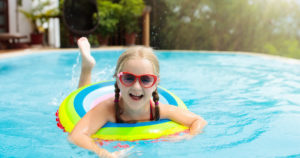Playing Safely Outside
June 11, 2020 Now that it is summer, kids are looking forward to playing outside. Popular activities like bicycling, jumping on trampolines, swimming, riding on hoverboards, and playing on home playground sets can all be made safer by following certain precautions.
Now that it is summer, kids are looking forward to playing outside. Popular activities like bicycling, jumping on trampolines, swimming, riding on hoverboards, and playing on home playground sets can all be made safer by following certain precautions.
Playground and Backyard Trampoline Safety
Although most public playgrounds and recreational facilities are still closed, many families have home playground sets or trampolines. According to data from the Centers from Disease Control and Prevention (CDC), most nonfatal playground-related injuries occur in public playgrounds but most fatal accidents happen on home sets. Some of the most common injuries that children and teens sustain while using playground equipment are:
- Severe fractures
- Dislocations
- Concussions and other traumatic brain injuries, or TBIs
- Amputations
- Internal injuries
The Consumer Product Safety Commission (CPSC) recommends that parents and caregivers take a few steps that are effecting in limiting preventable accidents from happening. With temperatures reaching the 90s, playground equipment can get so hot that it actually burns the skin. So, always touch plastic and metal surfaces yourself before letting children begin playing on it. Getting caught in equipment or attaching things like jump ropes or dog leashes to equipment can lead to strangulation, so be sure that children’s clothing does not have drawstrings and do not alter equipment in any way. Falls are one of the leading causes of playground-related injuries, but there are ways to minimize physical impact. Be sure that the surfaces underneath and around home playgrounds have somewhere between a 9-to-12 inch deep layer of mulch, wood chips, pea gravel, sand, or mats that are made of safety-tested rubber.
Trampolines can be very fun – but they can also be quite dangerous. Children are far more likely to sustain injuries on trampolines than teens and adults. In fact, children account for 90% of all injuries (such as sprains, fractures, and neck and head injuries) associated with trampoline use. Because there are such serious risks associated with home trampolines, the American Academy of Pediatricians (AAP) advises against having them or allowing children to use them altogether. If you have decided to install a home trampoline, it is critical to supervise children at all times. The CPSC also recommends setting some basic “ground rules”, like:
- Only allowing one jumper on the trampoline at a time
- No somersaults because they increase the chances for head, neck, and spinal injuries
Be sure to place trampolines as far from possible from trees and outdoor furniture or grills. It is also important to ensure that there is a net enclosure around the trampoline, and that there are shock-absorbing pads covering all hooks, springs, and the trampoline’s frame.
Hoverboards
Over the past few years the CPSC has recalled several hoverboards from the national market due to overheating and fire hazards. According to the AAP, more than 26,800 children visit hospital emergency departments with hoverboard injuries every year. To limit injuries and other product-related dangers, the CPSC says users should never charge or use a hoverboard unless it has a lab certification mark. Lab certification marks indicate that a hoverboard meets federal safety and manufacturing standards and requirements, and is usually labeled as “UL,” “ETL,” “CSA,” or “SGS”. However, even lab certification marks do not guarantee a product’s safety, and hoverboards are notoriously dangerous.
Other ways to prevent hoverboard injuries include:
- Always wearing a helmet
- Teaching children and teens to never ride a hoverboard in the street
- Always charging hoverboards within eyesight and never charging them overnight
- Having a working fire extinguisher somewhere readily accessible
If your child or teen has a hoverboard, make sure it is not under a recall.
Bicycle Safety
Bike riding is not only a popular summertime activity but it is also a great form of exercise. A study conducted by the Center for Injury Research and Policy found that on average, 35 children go to emergency departments for bicycle-related injuries every hour. Some of the most frequent injuries reported are traumatic brain injuries, bruises, scrapes, and cuts.
It is important to teach kids and teens about safe riding, which includes staying away from roadways and cars. Parents or caregivers should choose a safe riding area and need to be vigilant about supervising young, or inexperienced riders. Wearing a helmet saves lives and parents should always lead by example and wear a helmet themselves. A helmet should fit comfortably and snugly, and it should also comply with the CPSC’s safety standards for bicycle helmets (products that are in compliance will have a label indicating this). Helmets can break down over time or after someone gets into an accident, so check it regularly for signs of major wear and tear, such as degradation or cracks. If it is damaged, replace it immediately.
Swimming and Water Safety Tips
CPSC data confirms that drowning is the leading cause of accidental death in children under 4-years-old. The agency promotes the idea of teaching all young children to swim and says that parents should consider having young children regularly use life jackets as opposed to inflatable water wings or “floaties”. If you have a pool at home, it is crucial to secure it. You can secure a pool by installing a safe, lockable fence and also by putting a cover over it when it is not in use. When using the pool, make sure to remove the cover completely so that there is no risk of a child getting trapped underneath it.
Here are a few other tips from the CPSC for keeping kids safe while swimming at home or elsewhere:
- Designate a Water Watcher, or an adult who supervises children who are in the water at all times
- Teach children to stay away from pool drains, which create entrapment and drowning hazards. Certain pool drains are designed to reduce entrapment and drowning risks, so check to see if you have one that does. If not, install one.
- Install an alarm to alert you when someone enters the pool area. This can help prevent children from entering the area, falling in, and drowning, which can happen in just a split second.
We could not be more excited that summer is almost here – but we also want our readers and their loved ones to be safe while enjoying the weather and all the fun activities it brings along with it. If you have questions about an injury, a representative at our firm can help. Please contact us online now.
Philadelphia Personal Injury Lawyers at Galfand Berger, LLP Representing Injured Individuals Since 1947
With offices located in Philadelphia, Bethlehem, Lancaster, and Reading, Galfand Berger serves clients throughout Pennsylvania and New Jersey. To schedule a consultation, call us at 800-222-8792 or complete our online contact form.
 Google Screened
Google Screened
